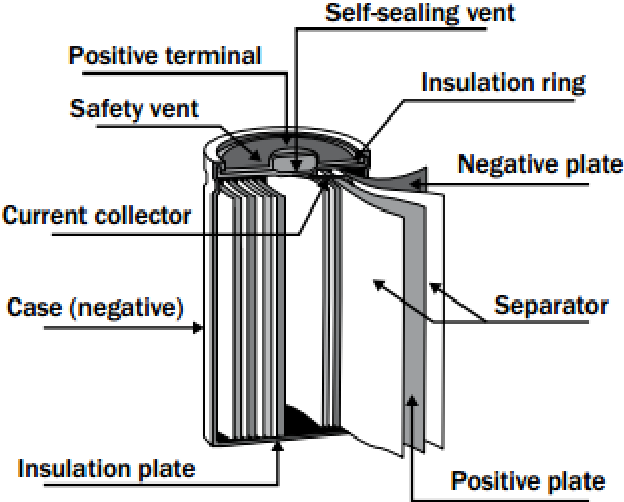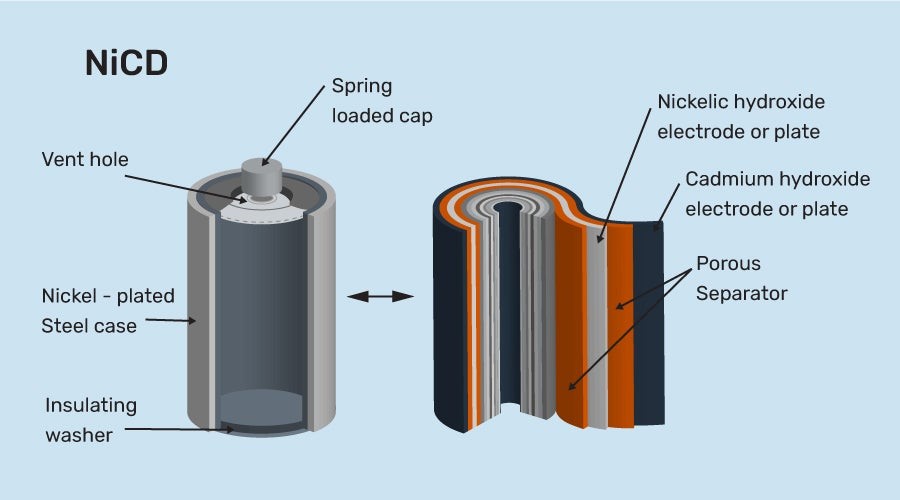NiCad vs NiMH |
There are some differences you should be aware of when deciding which popular rechargeable battery options, NiCad and NiMH, to use. The main features that may influence your decision when using one of these batteries are memory effect, capacity and how environmentally friendly it is. Further on, you can find out in detail the specific features of each battery type and how they differ from each other.
|
|
There are some differences you should be aware of when deciding which popular rechargeable battery options, NiCad and NiMH, to use. The main features that may influence your decision when using one of these batteries are memory effect, capacity and how environmentally friendly it is. Further on, you can find out in detail the specific features of each battery type and how they differ from each other.
NiCad Batteries |
A useful solution for many applications, Nickel-Cadmium (NiCad or NiCD) batteries consist of a nickel(III) oxide-hydroxide positive electrode plate, a potassium hydroxide electrolyte, a cadmium negative electrode plate, and a separator. With the many advances that came after Ernst Waldemar Jungner, a Swedish scientist first developed the NiCad battery in 1899, these batteries have become more efficient and more durable over the years.
Benefits of NiCad Batteries
NiCad batteries, which provide ease in many applications and make their use convenient, offer us various advantages. These advantages are:
- * Low-cost
- * Rapid charging
- * Handy to stock and ship
- * Capacity to carry a large number of Chargers
- * Operates in cold conditions
Able to withstand highly discharged applications, these batteries are often used in medical equipment, electric shavers, toys, two-way radios, emergency lighting, power tools, and a variety of commercial and industrial products.
NiCad batteries, which provide convenience in many applications and make their use convenient, offer us various disadvantages. These disadvantages are:
- * NiCad batteries are not as powerful as NiMH and other rechargeable batteries by comparison.
- * They tend to self-discharge when stored.
- Considering other rechargeable batteries they contain some toxic chemicals (which makes them less environmentally friendly).
With all these factors, many applications rely on these batteries for their convenience, affordability, amp-load capacity, and ability to withstand extreme temperatures.
NiMH Batteries |
 |
Nickel-metal hydride (NiMH) batteries, which entered our lives much more recently than their NiCad counterparts, started in 1967 at the Battelle-Geneva Research Center and completed its development in 1987, after a 20-year research and development period. Composed of a nickel hydroxide positive electrode plate, a hydrogen ion negative electrode plate, potassium hydroxide or another alkaline electrolyte, and a separator, NiMH batteries have higher capacity and longer charging times than NiCad batteries. In addition to all this, they are much more environmentally friendly compared to NiCad batteries and do not experience the same memory effect as NiCad batteries, meaning they continue to be fully charged with each use.
Benefits of NiMH Batteries
NiMH batteries come with several advantages, including:
- * A higher capacity in contrast with NiCad and other rechargeable batteries
- * Ability to counteract over-charging and over-discharging
- * Weightless structure
- * Eco-friendly
These advantages, which make NiMH batteries popular for many applications, especially consumer products, also make NiMH batteries frequently used in medical instruments, mobile phones, automotive batteries, digital cameras and video cameras, pagers, and electric toothbrushes.
NiMH batteries, which provide convenience in many applications and make their use convenient, offer us various disadvantages. These disadvantages are:
- * These batteries are more expensive than NiCad and other rechargeable batteries.
- * The possibility of cutting the current suddenly rather than gradually is very high.
- * Like NiCad batteries, they tend to self-discharge quickly when stored unused.
- * Some are only compatible with the manufacturer's own charger.
However, despite all the disadvantages, their increased capacity, lightness, and eco-friendly design make these batteries the most popular in the world.
Can NiMh and NiCad do the same job?
To some extent, Nickel Metal Hydride (NiMH) can be replaced by Nickel Cadmium (NiCad). Ni-MH can be used instead of Ni-Cad due to their equal rated voltage levels (1.2V). In such a case, please use a charger for your Ni-MH rechargeable batteries.
Can you replace a NiCad battery with a NiMH battery?
Yes, you can replace a NiCad battery with a NiMH battery. NiMH batteries have more benefits than NiCad batteries and they also have a longer shelf life than NiCad batteries. However, in devices that require more than one rechargeable battery, Ni-Cad and Ni-MH batteries cannot be used at the same time due to the different discharge characteristics. In case of such a need, the type and capacity of all batteries should be the same.
Do you need a BMS for your NiMH battery pack?
NiMH batteries do not require BMS to function. However, NiMH battery packs are among the most difficult batteries to charge properly. We also recommend that you have one in your design, as BMS solutions are both very cost-effective and provide a healthier performance.
Do you need a BMS for your NiCad battery pack?
NiCad batteries do not necessarily require BMS to function. Ni-Cad cells are very tolerant of overcharge and over-discharge, but still, having a BMS for a quality battery pack will extend the life of your product much longer.
Is the battery that will shape the future NiMH or Li-Ion?
Based on performance, Li-ion batteries outperform NiMH in most categories. Li-ion batteries have a longer overall life cycle of five years compared to NiMH batteries, which have a life cycle of two to five years.

